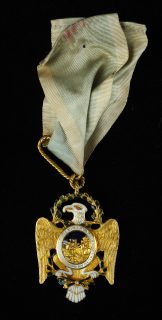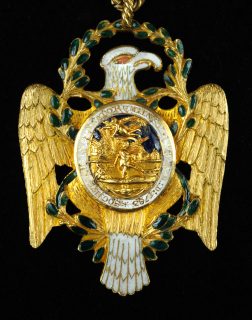
The Society of the Cincinnati insignia owned by Allan McLane is one of about a dozen examples made by silversmith Jeremiah Andrews known to survive.
The most recognizable symbol of the Society of the Cincinnati is its historic insignia, a gold badge that is as old as the American republic. Designed in 1783 by Pierre-Charles L’Enfant, the Society’s insignia took the shape of a bald eagle bearing scenes of its namesake, Lucius Quinctius Cincinnatus. The insignia, known as the Eagle, is an artistic expression of American independence and the nation’s republican ideals. The Institute owns the largest collection of Society of the Cincinnati Eagles in the world with more than sixty examples, and added to it in November 2018 with the acquisition of the eighteenth-century insignia originally owned by Revolutionary War hero Allan McLane.
Allan McLane (1746-1829), a Delaware officer who served for nearly the entire war, joined Caesar Rodney’s militia battalion in September 1775 and saw heavy combat in the New York and Philadelphia campaigns. In January 1777 McLane was promoted to captain in the Continental Army and given command of light troops that spent the next five years harassing British foraging parties and gathering intelligence for George Washington’s army. He distinguished himself in this role, even becoming the subject of a painting by James Peale depicting British soldiers ambushing McLane on a road outside Philadelphia (collection of the Utah Museum of Fine Arts).
After the war, Allan McLane joined the Society of the Cincinnati, founded in May 1783 to perpetuate the memory of the American Revolution and maintain the fraternal bonds between the officers. He initially joined the Delaware branch of the Society but, when it went dormant in 1802, he transferred his membership to the Pennsylvania Society. For McLane and other veteran officers, membership in the Society reflected pride in their role in the war that secured independence. The Society insignia was a symbol of their status as veteran officers of the Revolution, worn on occasions of ceremony and often depicted in their portraits. McLane wore his Eagle when he sat for an oil portrait by Charles Willson Peale in 1818 (collection of the Maryland Historical Society). Seven years later, McLane was elected treasurer general of the Society.
McLane’s Eagle was among the first insignias of the Society made in America. The first batch of Eagles ever made was produced in Paris in early 1784 under the direction of Pierre L’Enfant, a Frenchman who believed that only craftsmen from his country were skilled enough to make such a fine gold medal. Most of those 225 French-made Eagles arrived in Philadelphia in late April 1784 for sale to American Society members. With demand for the elegant insignia increasing quickly, local silversmith Jeremiah Andrews (d. 1817) became the first American craftsman to produce the Society Eagle. He manufactured and sold his version of L’Enfant’s design in Philadelphia from late 1784 until 1791. Andrews made Allan McLane’s Eagle during this period, although we have not found documentation of exactly when McLane purchased it. Andrews left Philadelphia for the South in 1791 and continued to sell his Society Eagles in Georgia and Virginia until at least 1794.

The reverse of the insignia shows the eagle facing its left.
This example generally follows L’Enfant’s design for the Society insignia, with distinctive modifications that Andrews made, including broad wings, a prominent beak and large, detailed medallions. It is a double-sided gold badge in the shape of a bald eagle with laurel branches arched over its head and secured in its talons. Oval medallions on each side of the insignia bear scenes of Cincinnatus, the ancient Roman embodiment of patriotic service and civic virtue. On one side, Cincinnatus accepts a sword from Roman senators, representing his leadership in defending the republic from foreign invaders. On the other side, Cincinnatus returns to his farm victorious—having relinquished his power once the crisis had ended—with the figure Fame flying overhead. The medallions are surrounded by the Society’s name and founding date, as well as its motto, Omnia Reliquit Servare Rempublicam (He gave all to serve the republic). The insignia is handsomely decorated with enamel, and is suspended from a light blue-and-white silk ribbon—colors representing “the Union of France and America,” according to the Society’s Institution.
Captain McLane’s Eagle descended in the family until it was acquired by the Institute, together with the Society insignia owned by his grandson, also named Allan McLane (ca. 1822-1891). The younger McLane’s Eagle was made by the venerable Tiffany & Co. of New York about 1885. Both McLane Eagles are gems of the Institute’s collection of the Society insignia.
See more information on this Eagle in the Institute’s online museum collections database.
View More Society Insignias